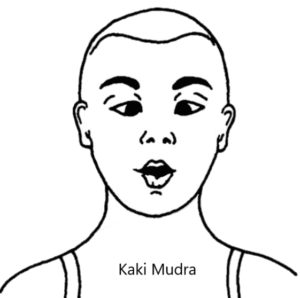Kaki Mudra
Introduction
Kaki Mudra is a pranayama-oriented mudra (breath-control gesture) rather than just a hand mudra. In this practice, the mouth is shaped like the beak of a crow (Kaki in Sanskrit means crow), and the breath is drawn through the lips. It is a cooling pranayama practice that balances body temperature, calms the nervous system, and rejuvenates internal organs. It is particularly effective in reducing stress, acidity, and excess heat (pitta dosha) in the body.
Meaning
Kaki = Crow
Mudra = Gesture/seal
The lips are shaped like a crow’s beak, symbolizing the precision and directness of energy flow. Just as a crow sips water carefully, in Kaki Mudra the practitioner inhales through the pursed lips (like sipping air) and exhales slowly through the nose, symbolizing mindful intake of prana.
How to Perform (Method of Practice)
Step-by-Step Instructions:
Sit in a meditative posture such as Padmasana, Sukhasana, or Vajrasana, keeping the spine erect.
Relax the shoulders and place the hands on the knees in Chin Mudra (index finger and thumb together).
Purse your lips into the shape of a crow’s beak (a small round opening).
Inhale deeply through the pursed lips, feeling cool air enter.
Close your lips, then exhale slowly and completely through the nose.
Keep eyes closed or gaze at the tip of the nose (Nasikagra Drishti).
Repeat for 5–10 rounds initially.
Advanced Practice: Can be combined with kumbhaka (breath retention) after inhalation for deeper pranic absorption.
Benefits
Physical Benefits:
Provides cooling effect on body, reducing excessive heat.
Improves digestion and liver function.
Relieves gastric acidity, ulcers, and constipation.
Improves respiratory efficiency and oxygen intake.
Helps in conditions like fever, hypertension, and skin problems caused by excess pitta.
Mental & Emotional Benefits:
Reduces stress, anger, and irritability.
Promotes calmness, focus, and clarity of thought.
Spiritual Benefits:
Activates Vishuddhi (throat) and Anahata (heart) chakras.
Helps conserve and channel prana for meditation.
Induces a sense of inner tranquility.
Contraindications
Avoid if suffering from cold, cough, sinusitis, or asthma (as inhaling through the mouth may worsen symptoms).
Not suitable for people with low blood pressure or chronic respiratory weakness.
Should not be practiced in extreme cold climates.
Avoid immediately after meals.
Anatomy & Physiology
Respiratory: Inhalation through the lips cools the breath, reducing internal body temperature and stimulating alveolar ventilation.
Digestive: Enhances liver, gallbladder, and stomach function by reducing acidity.
Circulatory: Helps regulate blood pressure through parasympathetic activation.
Thermoregulation: Balances body heat via cooling air intake.
Kinesiology
Engages orbicularis oris muscles of lips to form the beak-like shape.
Promotes controlled use of diaphragmatic breathing.
Creates postural stability by keeping spine erect and chest open.
Neurology
Activates parasympathetic nervous system, inducing relaxation response.
Reduces sympathetic overdrive linked with stress and anger.
Stimulates cranial nerves via pursed-lip breathing.
Enhances focus and awareness by directing attention to controlled breath.
Duration of Practice
Beginners: 3–5 minutes, 1–2 sessions per day.
Intermediate: 10–15 minutes daily.
Advanced: Can be integrated into pranayama sessions (20 minutes) with kumbhaka.
Counter Mudra
Surya Bhedana Pranayama (right nostril breathing) can be used as a counter to balance excessive cooling if body temperature drops too much.
Bhramari Pranayama (humming bee breath) may also complement Kaki Mudra for relaxation.
Conclusion
Kaki Mudra is a cooling, calming, and rejuvenating pranayama mudra that harmonizes the body’s water and fire elements, reduces stress, and supports digestion and respiratory health. Its simplicity makes it suitable for daily practice, especially in hot weather, or for individuals with excess pitta. However, it should be practiced with care in cold conditions or by those with respiratory issues.
FAQ
Q1: Can Kaki Mudra be practiced after eating?
No, wait at least 2–3 hours after meals.
Q2: Can children practice it?
Yes, but under supervision and for shorter durations.
Q3: Can it be practiced lying down?
Best performed in a seated posture for proper pranic flow.
Q4: When is the best time to practice?
Early morning or evening, in a calm and quiet environment.
Q5: Is it similar to Sitali Pranayama?
Yes, both are cooling practices. Kaki Mudra differs by using pursed lips instead of a rolled tongue.
References
Swami Satyananda Saraswati – Asana, Pranayama, Mudra, Bandha. Yoga Publications Trust.
B.K.S. Iyengar – Light on Pranayama.
Dr. H.R. Nagendra – Pranayama: The Art and Science.
Yoga Journal articles on cooling pranayamas and mudras.
Clinical studies on pranayama and autonomic nervous system regulation.

